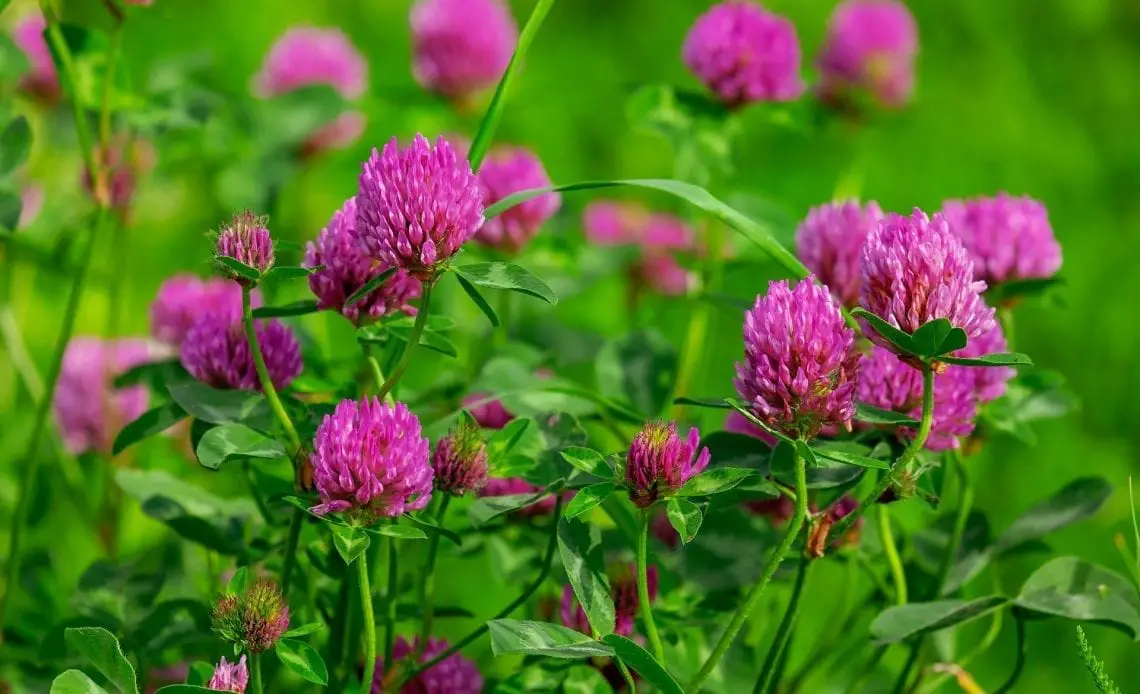
Last updated on May 23rd, 2023 at 02:50 am
Clovers are annual, biennial, and perennial flowering plants of Trifolium and the pea Family Fabaceae. They have small, fragrant, pea-like flowers and round, 3-lobed leaves. Clovers grow mostly in the Northern Hemisphere. Cultivated worldwide, the clovers are used as livestock feed, cover crops, and green manure.
The origin of the word clover is complex and ambiguous. Clover is linguistically linked to the Anglo-Saxon closure or clafre, the Dutch Klaver, the German Klee, Proto-Germanic Klaibron, and several other words. The most accepted theory is that the word clover derives from the West Germanic word klawaz, meaning ‘sticky pap,’ a reference to the sticky juice of clover.
The interpretation of the Latin name Trifolium is rather straightforward. The word comes from the Latin tres, which means ‘three,’ and folium, which means ‘leaf.’
Clovers are also known under the common name shamrock. Etymologically, this word is of Gaelic origin. It comes from the word seamrog, meaning “little clover .”
What does the Clover flower symbolize?
Clover is the only plant whose leaves are even more popular than its blossoms. There is a wealth of lore, legends, and symbolism about this plant. Undoubtedly the most widespread belief about clovers is the auspiciousness of a four-leaf specimen. The four-leaf clover is seen as a powerful magical talisman. “If you find an even ash or a four-leaved clover, rest assured you’ll see your true love ere the day is over.” This is a verse taken from an old magical charm from North England.
Clover has been used in magic and divination for centuries to foresee and attract romance, love, and marriage. For example, to dream of a clover meant having a happy and prosperous marriage. In Wales, it was believed that a two-leaved clover, if found by accident and put under the pillow, would reveal, through a prophetic dream, the future lover.
In some European countries, a girl or a young woman would place a four-leaf clover over a door. It was believed that the first man to walk through it would be her future husband. In a similar superstition from Quebec, a girl would place a four-leaf clover in her shoe. The first man she meets would be the namesake of her husband-to-be.
The ancients depicted hope as a little child standing on tiptoe, holding tight in his hand a clover flower. One reason for this flower’s symbolism of hope was the observation that clover sometimes grew in places that had never existed before. Today, many clover species are considered invasive exactly because of this property of ‘spontaneously appearing’ (spreading) in new areas.
In the Wikka tradition, finding a four-leaf clover was thought to bring good luck and enhance one’s mental and psychic powers. It was believed that four-leaf clovers grew only in places visited by the fairies, the elves, and the dwarfs.
There is a Cornish legend of a young milkmaid who once placed a handful of grass and a four-leaf clover on her head. She did so to relieve the pressure from the heavy bucket full of milk that she had to head-carry back home. As soon as the clovers touched her head, she could see hundreds of fairies, elves, and other tiny beings surrounding her.
The clover plant, however, is haunted by some dark beings, too. German folklore has the concept of feldgeister, or field spirits/demons, who dwell in the trees and plants. One of these demons is Kleesau, also known as Clover Sow. He resides in clover meadows and steals human children.
Another French tale tells that the devil spun the doodler (an opportunistic parasitic plant) at night, trying to destroy the clover flower. It was believed that the clover was a creation of God, while the dodder was the devil’s counter-plant.
The Celtic Triskelion symbol (the triple spiral motif) is one of the primary symbols of Paganism. It is believed that the leaf of the clover flower inspired the design. To the Druids, the clover was a talisman against evil spirits.
The Druid priests claimed that the clover enabled them to see evil entities and protect themselves against these dark forces.
All in all, the clover flower symbolic meanings are:
- luck
- good fortune
- protection
- faith
- hope
- love
Meaning of the Clover flower colors
Yellow color
There isn’t much meaning associated with this color yellow blossom that you won’t discover in other types of clover. They can be emblems of hope or hallowed locations of divinity.
According to an old legend, when God expelled Adam and Eve from the Garden of Eden, Eve took with her a four-leaf clover. Finding a four-leaf clover in a meadow brings a piece of Paradise into that person’s life.
Red color
In the flower language of the Victorian era, the red clover flower meant protection, success, money, love, fidelity, consecration, and exorcism. As a gift, the red clover flower conveyed the message ‘I promise.’
According to an old belief from Bohemia, a sprig of red clover secretly put in a husband’s shoe ensured his faithfulness, even if he traveled very far from home. A four-leaf clover under his pillow made certain he would dream of her.
It was also believed that the red clover could heal the aches of the heart. The heartbroken were advised to place a clover flower in a pouch made of blue silk and wear it near the heart.
In another tradition, the newlyweds tucked a clover plant into their shoes for a lasting and happy marriage.
Traditionally, red clovers were associated with money, success, and prosperity. It was once customary to carry a red clover flower while signing financial contracts and obligations.
The indigenous peoples of Virginia have a legend by which the flowers of the red clover have sprung from the blood of the red men slain in battle.
White color
In the language of flowers, the white clover flower shares some symbolic meanings with the red clover flower. The white clover, too, symbolizes promise, a happy and long marriage, masculinity, joyfulness, good luck, prosperity, and protection. It also stands for joyousness and lightheartedness, as it holds the promise of true love. The secret message conveyed through this flower is, ‘Think of me.’
White clover flowers are also a symbol of ethereal beauty. There is a legend of King Arthur’s nephew who wants to marry Olwen. The girl was so beautiful that she left a trail of white clover behind wherever she walked.
It was once believed that clover flowers could break a hex. When scattered around space, it removed any negativity and broke enchantments. Keeping white clover flowers in the pocket or a pouch around the neck was another way to break a magic spell and restore balance.
To the Druids, the clover flower was a sacred plant, and its three leaves symbolized the trinity of the Earth, the sky, and the sea. The white clover symbolized the spring equinox and an emblem of the triple goddesses. It was a symbol of the moon and the lunar influence.
In Ireland, the white shamrock is worn on St. Patrick’s Day. According to a legend, Saint Patrick used the white clover flower in the fifth century to teach king Aengus about the Christian belief in the Holy Trinity. The clover plant became a symbol of the Holy Christian Trinity (the Father, the Son, and the Holy Spirit), and the four-leaf one became a symbol of the Cross.
Interesting facts about the Clover flowers
- Clover flowers have also been used in traditional medicine. In Britain, red clover juice was used to treat sore eyes and snake bites. In Ireland, clover tea was used to soothe colds, coughs, and bee stings. On the Isle of Man, it was believed that smoking clover in a pipe could heal a toothache.
- Charles Darwin, the father of evolution, immortalized the red clover flowers in his work ‘Origin in Species.’
- The nineteenth-century English botanist Maxwell Masters described in his writings a ritual in which sorceresses, on a moonlit night, gathered white clover flowers.
- An alternative interpretation states that the three-leaf clover represents the trinity of love, hope, and faith, while the four-leaf one adds to these three a divine blessing.
How to grow Clover flowers
Clover flowers can grow in any condition and location. Like grasses, clovers grow pretty much anywhere they find themselves.
- Plant the clovers in full sun or partial shade with a minimum of four hours of sun exposure.
- Place them in a spot with enough sunlight.
- Water to keep the soil moist for the fastest growth.
- Apply all-purpose fertilizer during the flower’s growing season (spring and summer).
How to care for Clover flowers
- Keep the soil evenly moist, but let the surface dry between waterings to avoid root problems.
- During the summer, water regularly, moistening the top 6 inches of soil.
- Fertilize lightly once a month with a balanced fertilizer.
- Reduce feeding to every other month after blooming.
- Avoid fertilizing during the dormant season and winter when the plant’s growth slows.
- Remove the unwanted stems and flower stalks from the base and discard them.
Best time to gift Clover flowers
The clover flower is not an ornamental or a cut flower. It is not cultivated in flower nurseries nor sold in flower shops. It is a small-sized wildflower plant. With that in mind, clovers are not flowers to be gifted to someone on any formal occasion—a birthday, an anniversary, or a typical celebration.
A bouquet of clover flowers can be gifted spontaneously, for no big reason, to someone near and dear. During a picnic in the wild, they can be tied into a floral head wreath (flower crown).
Gifting a self-made bouquet of red clover flowers can be a romantic way of expressing love. Clovers are a perfect gift to friends and family members during the Midsummer Festival.
One should remember that the clover flowers carry a strong mystical symbolism. The ‘gypsy souls will always appreciate a gift of clovers,’ free spirits, indigo children, bohemians, romantics, and nature lovers.
Conclusion
This tiny flower has a lot of symbolism packed into its bulb-like and unique three-leafed shape, both agriculturally, historically, and even symbolically and spiritually.
There is so much that people may learn from clover flowers. Whatever your preference, clovers are here to stay, so choose your favorite and keep it in the house to fend against evil and convey luck to your home or loved ones.
If you want to know and learn more about flowers, we at PansyMaiden can help you. Check out our fun, easy-to-read, and informative flower-related content that you will surely enjoy!
